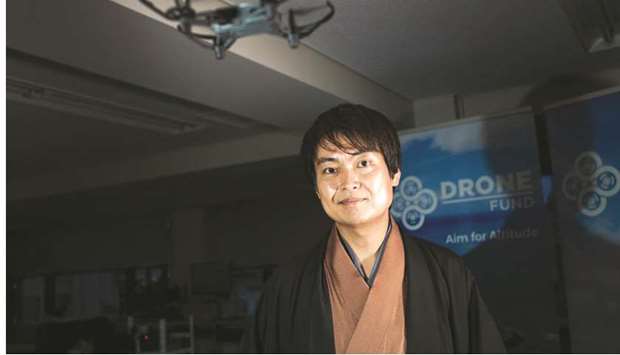The only person in a kimono at a recent Japanese government meeting on flying cars was Kotaro Chiba, a former online-game executive turned financier of a very specific kind.
For Chiba, 44, who wears the kimono on special occasions to show his pride in Japanese culture, is gathering money for what he calls the Drone Fund.
It invests in unmanned vehicles to survey buildings, make deliveries and take aerial photos for tourist boards; hover scooters; and a pilotless cargo craft that’s seeking to make it all the way from Japan to Silicon Valley in one go.
Chiba is at the forefront of an industry that’s only years away from changing our lives. In five to 10 years, the skies could be alive with drones delivering goods, according to McKinsey & Co. Ten to 15 years out, you could be heading to work in a flying taxi, the consultancy says. “It’s like a gold rush in the air,” Chiba said in an interview from his office in central Tokyo.
And “the first movers will reap the best results.”
Chiba’s fund forms part of Japan’s drive to regain its technological edge through drones after the country fell behind in other areas, such as ride-hailing, autonomous driving and connected cars.
But the country has work to do to catch up with other markets such as the US and China when it comes to the commercial drone industry.
Chiba started his first Drone Fund, which was small and oversubscribed, in 2017.
He put in ¥150mn ($1.3mn) of his own money.
He’s currently raising as much as ¥5bn for the second one, which he aims to close by the end of the year. He’s already lined up money from Mizuho Bank Ltd, KDDI Corp, and the Japanese soccer star and angel investor Keisuke Honda.
When that closes, he plans to gather as much as ¥50bn for a third one by about 2020. The Japanese government, which has provided some financial backing for the funds, is trying to create the laws and infrastructure needed to put flying cars into the sky in the next decade.
It formed a group in August for this purpose, which includes big names such as Uber Technologies Inc and Boeing Co.
The government sees uses for drone technology in everything from tourism to getting supplies to remote islands or mountainous areas in times of disaster. His ¥5bn fund will be a “drop in the ocean,” Chiba told attendees at the group’s inaugural gathering.
But if Tokyo could become the first city to prove that flying cars can work, money would surge into the area. A day after the meeting, Uber shortlisted Japan as one of the five locations it’s considering for the commercial launch of its air taxis. Venture funds specialising in drones are rare. The US-based Commercial Drone Fund and China’s DJI-backed Skyfund are the other two that have raised more than $10mn, according to Chiba.) That’s partly because they take more time to deliver returns than other investments.
But the potential market size is huge.
McKinsey estimates it could be as big as $46bn in the US alone by 2026. In Japan, it could reach $20bn by 2025, according to a forecast by Japanese drone startup Skyrobot Inc.
A major hurdle for integrating drones into society is concerns over safety. One deadly accident could set the nascent industry back by years. Another obstacle is the difficulty in creating a regulatory framework for the unmanned craft from scratch, which ties to both safety and privacy issues.
Japan is among the first countries to regulate the flying of hobby drones, banning them from densely populated areas, and its initial plan for drone taxis is to allow them to operate only between remote islands and in mountainous areas. Chiba has already made 22 investments in drone companies through his first fund. They include Aerial Lab Industries Inc, a startup that plans to introduce a bike that can hover a few meters above the ground in Tokyo in 2022.

Chiba: Countless drone companies will go public in the next five to 10 years.
